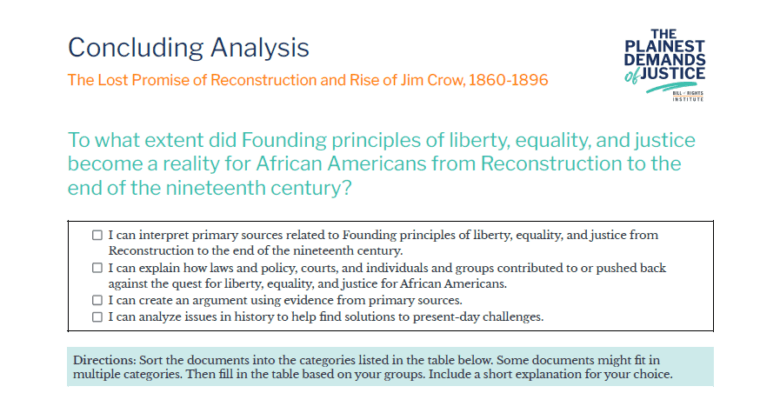Concluding Analysis: The Lost Promise of Reconstruction
To what extent did Founding principles of liberty, equality, and justice become a reality for African Americans from Reconstruction to the end of the nineteenth century?
- I can interpret primary sources related to Founding principles of liberty, equality, and justice from Reconstruction to the end of the nineteenth century.
- I can explain how laws and policy, courts, and individuals and groups contributed to or pushed back against the quest for liberty, equality, and justice for African Americans.
- I can create an argument using evidence from primary sources.
- I can analyze issues in history to help find solutions to present-day challenges.
Directions: Sort the documents into the categories listed in the table below. Some documents might fit in multiple categories. Then fill in the table based on your groups. Include a short explanation for your choice.
| Document Title and Date | Laws and Policy | The Courts | “We the People” – individuals and groups |
|---|---|---|---|
| Thirteenth Amendment, 1865 | Constitutional amendment banning slavery | ||
| General Order No. 3, June 19, 1865, U.S. Major General Gordon Granger | |||
| Frederick Douglass, “What the Black Man Wants,” 1865 | |||
| The Freedmen’s Bureau Act of 1865 | |||
| An Act to Confer Civil Rights on Freedmen, and for Other Purposes, 1865 (Mississippi Black Code) | |||
| Civil Rights Act of 1866 | |||
| Attacking the Freedmen’s Bureau Poster, 1866 | |||
| Fourteenth Amendment, 1868 and Fifteenth Amendment, 1870 | |||
| African Methodist Episcopal (A.M.E.) Pastor S. B. Williams Reports Atrocities to North Carolina Governor Holden, 1869 | |||
| Albion W. Tourgée’s Letter to Senator Joseph C. Abbott, 1870 | |||
| Thomas Nast, “The Union As It Was,” 1874 | |||
| Congressman Robert B. Elliott’s Speech in Support of the Civil Rights Act, January 1874 | |||
| Congressman James T. Rapier’s Speech in Support of the Civil Rights Act, February 1875 | |||
| Civil Rights Act, 1875 | |||
| Strauder v. West Virginia, 1880 | |||
| Frederick Douglass, “The Blessings of Liberty and Education,” 1894 | |||
| Booker T. Washington, Atlanta Exposition Address, 1895 | |||
| Plessy v. Ferguson, 1896 | |||
| Images from Historically Black Colleges and Universities, 1866–1900 |
- How did leaders invoke the Founding principles of liberty, equality, and justice during Reconstruction and the rise of the Jim Crow era?
- What causes, if any, were there for optimism in the fight for equality for the African American community at the end of the nineteenth century?
- How were laws, courts, and individuals and groups’ words and actions complementary and how were they in conflict during this period? In other words, did the courts and laws support each other, or did they contradict each other? Did individuals and groups work within the confines of current laws and policies or push back against them? Give examples from specific documents to support your answer.
- To what extent did the Founding principles of liberty, equality, and justice become a reality for African Americans in this time period? Support your answer using evidence from the primary sources provided, as well as your own knowledge of U.S. history.
